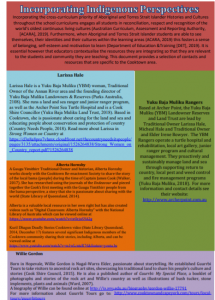5 Incorporating Indigenous Perspectives
Jacynta Hunt
I really want exposure and access to Indigenous cultural resources. Where can I source local knowledge and stories that are actually meaningful and within a context that my local Indigenous children understand?
Rationale
To address the educators’ concerns relating to accessing local Indigenous knowledge and cultural resources, the document ‘Embedding Indigenous Perspectives’ (above) was created. It could be presented in a staff meeting, as professional development or in educator employment packages to introduce educators to the expectation that Indigenous perspectives should be integrated in planning and to aid them doing so in a meaningful and contextualised way by utilising the local contacts provided. The resource presents synopses of some local Indigenous sources, Traditional Owners and Elders who could provide educators with relevant and localised stories and culture.
Engaging Indigenous children and their families in all aspects of school is identified as key to holding high expectations and improving educational outcomes (Ministerial Council on Education, Employment, Training and Youth Affairs, 2008). Respect for diversity is recognized as a principle of the Early Years Learning Framework and means that educators value the histories, stories, traditions and practices of children’s families (DEEWR, 2009). Reflecting these within the curriculum fosters motivation to learn and each child’s self-esteem and identity (DEEWR, 2009); however, many teachers feel they lack sufficient understanding of Indigenous cultures to teach it without risk of offense and therefore either do not teach Aboriginal and Torres Strait Islander perspectives, or do so in a superficial manner (Booth, 2014).
By directly contacting Cooktown local experts, students benefit from authentic lived experiences, stereotypes can be discredited and educators are offered better understanding of culturally appropriate protocols (Cooper, He & Levin, 2011). Bronfenbrenner’s (1981) ecological theory poses that the systems that a child exists in (such as home, school, community) are interconnected and symbiotic in their influence. Furthermore, Owens & Wang (1996, cited in Cooper, He & Levin, 2011 p. 140) state that “intelligence and expertise are built out of interaction with the environment, not in isolation from it”; as such, educators should continuously strive to build their knowledge of Indigenous cultures through respectful and authentic relationships with families and the local Aboriginal or Torres Strait Islander community (University of Southern Queensland, 2019a). The resource provides teachers with a starting point in building these relationships specifically with the Gungardie (Cooktown) people, the Guugu Yimithirr and websites that can be used present the bama’s (Aboriginal people) perspective.


